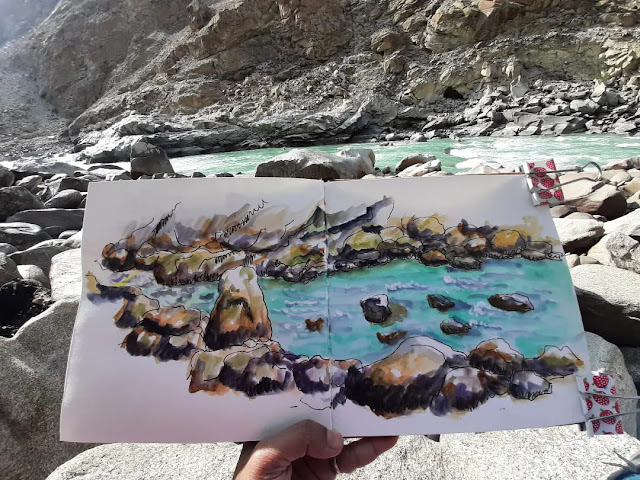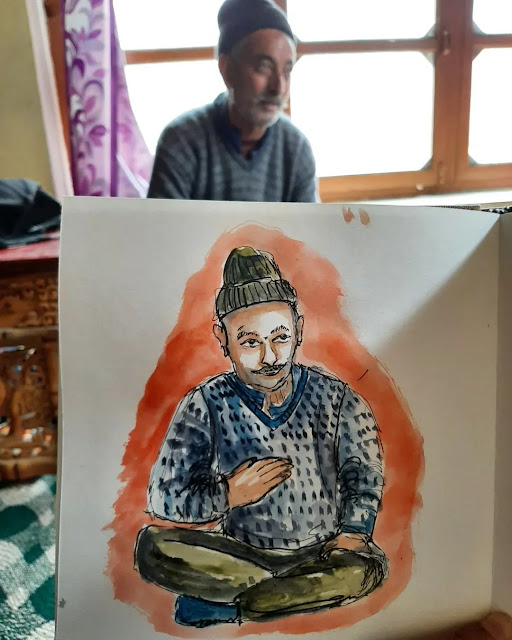I spent five enriching days in Garkon, home to the Brokpa/Aryan/Dardic tribe, during the Apricot Blossom Festival in April 2022. My earlier plan was to spend two days in Garkon, but thanks to the bad experience in the Achinathang homestay (read my previous blog), I shortened my stay at Achinathang and spent two more days at Garkon. I took a bus from Achinathang to Garkon and reached the Payupa Guest House, run by Diskit and her husband Tashi Lundup. It is a multi-storied house with several rooms. Since I was traveling solo, they gave me a room on the ground floor with a shared bathroom and toilet.
This was the first sketch I did of the view outside.
 |
| Warming up for the Garkon sketch series |
I met a very interesting person in Garkon. He is the folk singer of the village, Sonam Wangyal, and was a storehouse of information about Brokpa culture and history. One thing he said was interesting. It was one of his relatives who had gone to graze his cattle on the border who discovered the infiltration of Pakistani terrorists on the border and informed the Indian Army, which eventually led to the Kargil war in 1999.
 |
| Two young Brokpa girls |
 |
| Two young Brokpa girls |
I was lucky that on the day I was there, 14th April 2022, the Apricot Blossom Festival, locally called Chuli Menduq was being organized by the Department of Tourism. All the Brokpas from Garkon and the neighboring villages came in all their traditional attire and finery.
 |
| The floral headgear for Brokpa women called Molan Kho |
 |
| Monthu Tho- the most important flower for the Brokpas |
I also sketched the Brokpa footwear and pants worn by women.
The shoes are called 'Aala Peela'. Peela means shoes in their language. The bottom part is made of goat leather and the upper part of wool. So colorful! I am considering joining the Brokpa tribe for their sheer love for bright colours.
The pant is worn underneath the kaftan or Kurta and is made of wool with rich embroidery in bright colors. It was quite heavy to hold.
 |
| Brokpa women's pants |
 |
| Brokpa shoes called Aala Peela |
I wanted to do another portrait of a Brokpa woman and the mother of my homestay owner sweetly agreed to pose for me. The Brokpa women wear their hair in 14 plaits. 4 on each side and 6 behind. This lady told me when she was young, they had to comb their hair everyday and plait it. They never cut their hair. But now things have changed. She said earlier, rajma (kidney beans) and corn and other seeds were used as part of their attire. The silver used to come from Skardu, now in Pakistan. The traders would exchange salt in exchange for silver.
Brokpa girls from the back. They wear a cape made of goat skin and until two generations ago, girls weren't allowed to go outside or be seen by men without the goat skin.
 |
| The cape of the Brokpa girls. |
 |
| The traditional attire of the Brokpas is elaborate and heavy! |
I got the opportunity to watch and sketch Brokpa musicians on percussion and wind instruments. The Brokpa songs are all about Nature, about Apricot blossoms, the river, the mountains. They share a close connection to nature like most people in the villages.
The wind instrument is called Surna, the tabla like instrument is called Daman, the sticks are called Danshing and the single percussion instrument is Bhoonsh.
You may like to read my post on the Lepcha tribe in Sikkim.
 |
| Brokpa men with floral headgear |
The 2nd floor is called Sbyarkhang, used in summer. The 3rd floor is a prayer room called Chokthang. 4th floor is the terrace.
 |
| Brokpa museum in Garkon |
 |
| Collection of museum artifacts |
 |
| Indus river in Garkon |
As I was wandering around the village, a young man Phunchok invited me to see his newly renovated guest house called Betepa Guesthouse. He offered me tea and I sat on the terrace and sketched this panoramic view.
 |
| Phunchok of Betepa Guest house in Garkon |
As I had mentioned earlier, the Brokpas have kept their animist traditions alive alongside the Buddhist practices. This is the sacred walnut tree of the village called Changri Aatho, where their guardian spirit is believed to be residing. Every year, the Brokpa villages take turns celebrating the Bon festival called Bonona. So Garkon gets its chance every three years. The tree and stone are worshipped and offered holy fumes called Phok (juniper leaves). The first harvest of the season is also offered to the tree and villagers come in traditional attire and sing and dance in celebration.
During the Apricot blossom festival, the men and women performed a folk dance. It was a slow-moving dance but very graceful and the dancers sang in chorus. One of the women offered me a headgear. It was very heavy on my head. The songs they sang were about Nature, love, river and mountains.
A coffee table at Paupa guesthouse with Tibetan Buddhist motifs. This kind of decor is ubiquitous in the regions practicing Tibetan Buddhism such as Sikkim, Arunachal Pradesh, Ladakh, and parts of Himachal Pradesh.
My hostess at Payupa Guest House, Diskit, made this syrupy side dish with dried apricots which are just boiled in plain water. The result is a syrupy jam-like dish that pairs well with rice-dal and rotis.
Seeing me sketch at the Chuli Menduq, a Tourism minister of Ladakh, Aga Syed Taha, asked me to draw a portrait of him. I said I did not have loose papers and that I wouldn't tear a page from my sketchbook. He managed to get some A4 printer paper and asked me to draw on that.













Girls in that outfit holding their painting was my favorite
ReplyDeleteHostels in Leh
This comment has been removed by the author.
ReplyDeleteWhat a fascinating glimpse into the Brokpa culture! The floral headgear and their connection to nature are so unique and inspiring. Thank you for sharing this detailed travelogue!"
ReplyDeletefranchise Expo
franchise Expo Mumbai
"Your sketches bring the culture to life beautifully! I loved learning about the Monthu-tho flower and its symbolic role in the community. Truly amazing!"
ReplyDeletefranchise Expo Bangaluru
Trough Screw Conveyor delhi
"The historical connection with Alexander's soldiers is so intriguing. It's incredible how the Brokpa tribe has preserved its identity and traditions for so long."
ReplyDeleteAutomatic Bag Slitting Machine
Micro feed screw delhi
"I never knew about the Brokpa attire being such a rich blend of materials from nature. The silver, pearls, and goat leather make their clothing a true celebration of the earth!"
ReplyDeleteWarehouse Storage rack
mezzanine floor
"Your storytelling, paired with the vivid sketches, makes me feel like I’m right there in Garkon. The 500-year-old house-turned-museum is an absolute gem of history!"
ReplyDeletemobile compactor in delhi
fifo flow rack manufacturer
"The Apricot Blossom Festival sounds like a riot of colors and joy! Your experience seems incredible, and the way you captured it is just magical."
ReplyDeleteheavy duty rack delhi
Multi tier rack delhi
"I loved reading about the musical traditions of the Brokpas. The instruments like the Surna and Daman sound fascinating. Do you have any sketches of the musicians?"
ReplyDeleteSlotted Angle rack delhii
Pallet rack manufacturer
"The concept of polyandry and animist traditions surviving alongside Buddhism is so interesting. Thanks for shedding light on this lesser-known community!"
ReplyDeleteDust Collector
Franchise Opportunities
QUICK EASY EMERGENCY URGENT LOANS LOAN OFFER EVERYONE APPLY NOW +918119841594 adamibrahimfinanceltd1976@gmail.com Adam Ibrahim
ReplyDeleteBeautiful sketches, i am amazed, curious to know, how did you learn?
ReplyDelete